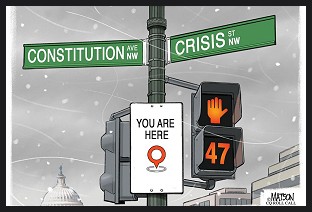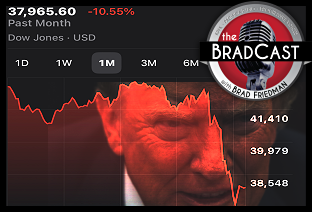 Following up on the latest monumental failure by Diebold/Premier --- whose voting system was recently found by a citizens' transparency project to have lost hundreds of ballots in a single precinct in Humboldt County, CA --- Wired's Kim Zetter covered the issue earlier this week.
Following up on the latest monumental failure by Diebold/Premier --- whose voting system was recently found by a citizens' transparency project to have lost hundreds of ballots in a single precinct in Humboldt County, CA --- Wired's Kim Zetter covered the issue earlier this week.
Her article touched on a number of technical issues involved in the failure of the Diebold GEMS central tabulator which, though we hadn't noted them in our own coverage, are nonetheless important, even if somewhat down in the weeds, and perhaps most of note to technical election integrity geeks only.
As quoted below in some detail from Zetter's report, she advances the story by noting:
- The problem, which Diebold admits has been in its system for years, likely wouldn't have been noticed at all were it not for the unique, experimental, citizen-led "Humboldt Transparency Project." Even CA's required 1% random post-election "audit" wouldn't have uncovered the problem, since absentee ballots are not included in that audit.
- The chances of the problem occurring, which resulted in ballots being deleted without notice by the Diebold GEMS tabulator, are rather high, even if chances of discovery of the error by election officials are very low.
- Diebold's explanation for the failure may or may not be legitimate.
- The GEMS internal "audit logs" (the GEMS system was used in 34 states around the nation last November) aren't actually audit logs at all, and may not actually note the complete set of events which occurred on the voting system, even if anyone is allowed to review those logs in the first place.
Let's take a look at the details...
Thanks to the unique oversight program allowed by Humboldt County's election chief Carolyn Crnich, the deck of some 200 absentee ballots scanned, but then deleted from the totals without notice by the Diebold/Premier GEMS tabulator, was discovered and the previously-certified results had to be corrected and re-certified.
The special project used open-source software, written locally, and off-the-shelf scanners to scan the same paper ballots that were scanned and tabulated by the Diebold op-scan system. However, had it not been for that parallel counting project, using alternate hardware and software, the previously-certified results --- which did not include the ballots deleted by Diebold --- would have stood, and the lost ballots would likely never have been found, as Zetter notes:
The audit requires every county to hand-count ballots in 1 percent of randomly chosen precincts in order to compare the totals against digital tallies. But the audit involves only ballots cast physically at a precinct, not mail-in ballots, which are the ballots that the Premier/Diebold system dropped in Humboldt. Even if the Humboldt ballots had been precinct-cast ballots, Crnich would not have known they'd been dropped from the system if they weren't cast in a precinct that was included in the 1 percent of precincts that were hand counted.
But while the chances of the problem that occurred in Humboldt are actually very high, the chances of discovering the failure are low, unless the ballots are rescanned or recounted by an alternate system that actually works, like the one created by citizens, for free, on open-source software in Humboldt...
The system never provides any indication to election officials when it's deleting a batch of ballots in this manner.
That last graf, noting that no indication of the error is given to officials, is both troubling and reminiscent of Diebold's other recent admission that its GEMS central tabulator --- on both the paper ballot systems and touch-screen systems --- routinely drops thousands of ballots when they are uploaded to the central GEMS server, but without giving any indication of that failure to the system administrator, who is left believing that all votes were properly recorded.
Ohio's Secretary of State Jennifer Brunner is currently suing Diebold/Premier over that particular failure, as she and I discussed in an exclusive interview late in the Summer, though no other state --- including California --- is currently suing Diebold/Premier to our knowledge. That, even though the same GEMS system is currently used in some 34 states around the nation.
With all of this, however, it's not even certain that the reason Diebold offers for the deletion of those ballots was actually the reason for the deletion, as noted by Zetter:
And, as if all of that is not bad enough, as they say on Late-Night TV: But wait! There's more! And, ultimately, it could be the worse flaw of all!
As it turns out, the GEMS system's internal audit logs, used (when election officials and/or courts will allow it) to look back and determine what operations were actually carried out by the system and when, doesn't appear to be a real "audit log" at all!
Rather, as Parke Bostrom, one of the Humboldt citizens who worked on the project described it, the audit log is actually a "'re-imagining' of what GEMS would like the audit log to be, based on whatever information GEMS happens to remember at the end of the vote counting process."
The system creates a "deck 0" for each ballot type that is scanned. This means, the system should have three "deck 0" entries in the log --- one for vote-by-mail ballots, one for provisional ballots, and one for regular ballots cast at the precinct. Crnich found that the log did show a "deck 0" for provisional ballots and precinct-cast ballots but none for vote-by-mail ballots, even though the machine had printed a receipt at the time that an election worker had scanned the ballots into the machine. In fact, the regular audit log provides no record of any files that were deleted, including deck 132, which was deleted when Crnich intentionally aborted it. She said she had to go back to a backup of the log, created before the election, to find any indication that "deck 0" had ever been created.
Parke Bostrom, one of the Transparency Project volunteers, wrote in a blog post about the issue, "This means the audit log is not truly a 'log' in the classical computer program sense, but is rather a 're-imagining' of what GEMS would like the audit log to be, based on whatever information GEMS happens to remember at the end of the vote counting process."
Zetter didn't offer the link to Bostrom's blog post, but it's right here. He notes, in addition to the points mentioned by Zetter above, what appears to be a contradiction to her reported information on the other two "deck 0" batches --- for provisional ballots and for mail-ballot-precincts (those precincts that are too small and remote to have actual physical precincts, so they are all done as vote-by-mail).
While Zetter notes that the other two "deck 0" batches did show up as having been scanned in the "audit log," in fact Bostrom notes that they "do not appear in the audit log, but apparently their votes are included in the final report."
Not sure whether it's Bostrom or Zetter who has that point correct, and I've been on the road and out-of-pocket for weeks, so don't have the time for the moment to find out. But, suffice it to say, if we're talking about "audit logs" that are made at the end of the process, instead of concurrently, as events occur, then they are worthless for purposes of auditing, no matter what.
Bostrom adds one other point of note in his blog item which illustrates just how difficult it is to audit the job that Diebold's GEMS system --- again, it's used in 34 states! --- has done in scanning ballots, even if (and that's a big "if"!) officials and/or courts allow regular citizens to examine the system at all:
As we noted in our Monday coverageof this story, this entire sorry affair reveals yet again the enormous scam behind the entire federal e-voting legislation contained in the Help America Vote Act (HAVA) of 2002, allocating some $3.9 billion for states to hand over to private voting machine corporations like Diebold for their proprietary trade secret-protected voting systems which don't work.
In the meantime, on the other hand, a handful of citizens in Humboldt County, using fully open source code, developed at no cost to the county, with off-the-shelf commercial scanners, have created a system in a number of months that did a better job of counting ballots than Diebold, even with all of their millions/billions of tax-payer dollars, hundreds of programmers, secret hardware and software, and enormously expensive long-term maintenance contracts.
HAVA also created the U.S. Election Assistance Commission (EAC) which was supposed to have served as a "clearinghouse" for voting system problems such as the one that hit Humboldt. The flaw in Diebold's system has been known since 2004, but the EAC failed to notify anybody about it, and has failed to set up any useful clearinghouse system at all, in the 6 years since HAVA was signed into law.
Given all of those failures, every jurisdiction in the country which insists on using optical-scanners should immediately look at moving over to the software and hardware developed by the citizens in Humboldt. Diebold/Premier should be dumped, sued for fraud, malfeasance, and gross negligence and be put out of business --- at least the elections business --- once and for all.
As to what should happen to the EAC, we'll leave that for now, for another day...


 Campaign to 'Impeach Trump Again' Gains Fresh Momentum: 'BradCast' 4/29/25
Campaign to 'Impeach Trump Again' Gains Fresh Momentum: 'BradCast' 4/29/25 'Green News Report' 4/29/25
'Green News Report' 4/29/25
 And Then They Came for the Judges...: 'BradCast' 4/28/25
And Then They Came for the Judges...: 'BradCast' 4/28/25 Sunday 'Desperation' Toons
Sunday 'Desperation' Toons Trump EPA Guts Enviro Justice Office: 'BradCast' 4/24/25
Trump EPA Guts Enviro Justice Office: 'BradCast' 4/24/25 'Green News Report' 4/24/25
'Green News Report' 4/24/25 Nation's Largest Broadcaster Hoaxes Viewers to Help Gut FCC Rules: 'BradCast' 4/23/25
Nation's Largest Broadcaster Hoaxes Viewers to Help Gut FCC Rules: 'BradCast' 4/23/25 Trump's FCC on Precipice of Ending All Limits on Corporate Control of Local TV Stations
Trump's FCC on Precipice of Ending All Limits on Corporate Control of Local TV Stations GOP Earth Day 2025 Hypocrisies and Dilemmas: 'BradCast' 4/22/25
GOP Earth Day 2025 Hypocrisies and Dilemmas: 'BradCast' 4/22/25 'Green News Report' 4/22/25
'Green News Report' 4/22/25 Pope Francis Dies, Trump Still Alive and Criming: 'BradCast' 4/21/25
Pope Francis Dies, Trump Still Alive and Criming: 'BradCast' 4/21/25 Sunday
Sunday  Sunday 'Zero Day' Toons
Sunday 'Zero Day' Toons 'Green News Report' 4/10/25
'Green News Report' 4/10/25 Soc. Sec. Expert Warns DOGE of Collapse, Privatization: 'BradCast' 4/10/2025
Soc. Sec. Expert Warns DOGE of Collapse, Privatization: 'BradCast' 4/10/2025 Trump Blinks, Chaos Reigns, Markets Spike Amid Tariff 'Pause': 'BradCast' 4/9/25
Trump Blinks, Chaos Reigns, Markets Spike Amid Tariff 'Pause': 'BradCast' 4/9/25 SCOTUS Deportation Ruling Grimmer Than First Appears: 'BradCast' 4/8/25
SCOTUS Deportation Ruling Grimmer Than First Appears: 'BradCast' 4/8/25 Cliff Diving with Donald: 'BradCast' 4/7/25
Cliff Diving with Donald: 'BradCast' 4/7/25 'Mob Boss' Trump's Trade Sanctions Tank U.S., World Markets: 'BradCast' 4/3/25
'Mob Boss' Trump's Trade Sanctions Tank U.S., World Markets: 'BradCast' 4/3/25 Crawford Landslide in WI; Booker Makes History in U.S. Senate: 'BradCast' 4/2/25
Crawford Landslide in WI; Booker Makes History in U.S. Senate: 'BradCast' 4/2/25 Judge Ends Challenge to GA's Unverifiable, Insecure Vote System: 'BradCast' 4/1/25
Judge Ends Challenge to GA's Unverifiable, Insecure Vote System: 'BradCast' 4/1/25 Bad Court, Election News for Trump is Good News for U.S.: 'BradCast' 3/31
Bad Court, Election News for Trump is Good News for U.S.: 'BradCast' 3/31
 VA GOP VOTER REG FRAUDSTER OFF HOOK
VA GOP VOTER REG FRAUDSTER OFF HOOK Criminal GOP Voter Registration Fraud Probe Expanding in VA
Criminal GOP Voter Registration Fraud Probe Expanding in VA DOJ PROBE SOUGHT AFTER VA ARREST
DOJ PROBE SOUGHT AFTER VA ARREST Arrest in VA: GOP Voter Reg Scandal Widens
Arrest in VA: GOP Voter Reg Scandal Widens ALL TOGETHER: ROVE, SPROUL, KOCHS, RNC
ALL TOGETHER: ROVE, SPROUL, KOCHS, RNC LATimes: RNC's 'Fired' Sproul Working for Repubs in 'as Many as 30 States'
LATimes: RNC's 'Fired' Sproul Working for Repubs in 'as Many as 30 States' 'Fired' Sproul Group 'Cloned', Still Working for Republicans in At Least 10 States
'Fired' Sproul Group 'Cloned', Still Working for Republicans in At Least 10 States FINALLY: FOX ON GOP REG FRAUD SCANDAL
FINALLY: FOX ON GOP REG FRAUD SCANDAL COLORADO FOLLOWS FLORIDA WITH GOP CRIMINAL INVESTIGATION
COLORADO FOLLOWS FLORIDA WITH GOP CRIMINAL INVESTIGATION CRIMINAL PROBE LAUNCHED INTO GOP VOTER REGISTRATION FRAUD SCANDAL IN FL
CRIMINAL PROBE LAUNCHED INTO GOP VOTER REGISTRATION FRAUD SCANDAL IN FL Brad Breaks PA Photo ID & GOP Registration Fraud Scandal News on Hartmann TV
Brad Breaks PA Photo ID & GOP Registration Fraud Scandal News on Hartmann TV  CAUGHT ON TAPE: COORDINATED NATIONWIDE GOP VOTER REG SCAM
CAUGHT ON TAPE: COORDINATED NATIONWIDE GOP VOTER REG SCAM CRIMINAL ELECTION FRAUD COMPLAINT FILED AGAINST GOP 'FRAUD' FIRM
CRIMINAL ELECTION FRAUD COMPLAINT FILED AGAINST GOP 'FRAUD' FIRM RICK SCOTT GETS ROLLED IN GOP REGISTRATION FRAUD SCANDAL
RICK SCOTT GETS ROLLED IN GOP REGISTRATION FRAUD SCANDAL VIDEO: Brad Breaks GOP Reg Fraud Scandal on Hartmann TV
VIDEO: Brad Breaks GOP Reg Fraud Scandal on Hartmann TV RNC FIRES NATIONAL VOTER REGISTRATION FIRM FOR FRAUD
RNC FIRES NATIONAL VOTER REGISTRATION FIRM FOR FRAUD EXCLUSIVE: Intvw w/ FL Official Who First Discovered GOP Reg Fraud
EXCLUSIVE: Intvw w/ FL Official Who First Discovered GOP Reg Fraud GOP REGISTRATION FRAUD FOUND IN FL
GOP REGISTRATION FRAUD FOUND IN FL


































